Schedule Your Consultation with Dr. Prasad Here
- Home
- About Dr. Prasad
- Face & Eyes
Eyelifts
- Eyelid Surgery
- Eye lift Before and After Photos
- Asian Eyelid Surgery
- Upper Eyelid Surgery
- Upper Eyelid Hollow / Lower Brow Hollowing
- Under Eye Bag Surgery
- Eyelid Ptosis Surgery
- Transconjunctival Blepharoplasty
- Under Eye Fillers
- Eyelid Surgery Revision Specialist
- Thyroid Eye Disease
- Tear Trough Implants
- Eye Lift Questions and Answers
- Body
- Injectables
- Laser
- Hair Restoration
- Photos
- Hair Restoration Before and After Photos
- Eye lift Before and After Photos
- Upper Blepharoplasty Before and After
- Ptosis Surgery Before And After
- Facelift Before and After Photos
- Lip Enhancement Before and After Photos
- Under Eye Filler Before and After
- Blepharoplasty Before and After
- Lower Blepharoplasty Before and After Photos
- Eyelid Surgery Before and After
- Double Eyelid Surgery Before and After
- Contact Us
- Home
- About Dr. Prasad
- Face & Eyes
Eyelifts
- Eyelid Surgery
- Eye lift Before and After Photos
- Asian Eyelid Surgery
- Upper Eyelid Surgery
- Upper Eyelid Hollow / Lower Brow Hollowing
- Under Eye Bag Surgery
- Eyelid Ptosis Surgery
- Transconjunctival Blepharoplasty
- Under Eye Fillers
- Eyelid Surgery Revision Specialist
- Thyroid Eye Disease
- Tear Trough Implants
- Eye Lift Questions and Answers
- Body
- Injectables
- Laser
- Hair Restoration
- Photos
- Hair Restoration Before and After Photos
- Eye lift Before and After Photos
- Upper Blepharoplasty Before and After
- Ptosis Surgery Before And After
- Facelift Before and After Photos
- Lip Enhancement Before and After Photos
- Under Eye Filler Before and After
- Blepharoplasty Before and After
- Lower Blepharoplasty Before and After Photos
- Eyelid Surgery Before and After
- Double Eyelid Surgery Before and After
- Contact Us
Laser Tattoo Removal
About 45 million Americans have at least one tattoo, with about 20% of them suffering from “tattoo regret”.
There are many reasons for wanting a tattoo removed. One reason is “I was too immature when I had the tattoo done”. In addition employment/ business reasons are the basis for having tattoo removal.

Challenges of Tattoo Removal
While tattoo removal may seem like a generic procedure, it is actually one of the more challenging procedures in cosmetic medicine. Who performs your treatment is extremely important. Laser tattoo removal has been around for quite some time, but there is a difference in older lasers used for tattoo removal than some of the more modern lasers.
Dr. Prasad will help you understand the number of treatment sessions required based on your skin type, the type of ink, the color as well as other important factors. It is generally known that Dr. Prasad’s lasers can remove more ink with fewer treatment sessions, and can penetrate deeper into skin layers to remove more ink. All laser tattoo removal will require several sessions spaced apart for best results.
Factors Which Can Affect Success of Tattoo Removal
- Scarring or skin damage, including keloid (raised) scars
- Infection
- Ink/ tattoo still visible after several sessions
- Pain
- Different ink colors
- Different types of tattoos – amateur or professional, large or small
- Multiple treatment sessions
- Hypopigmentation – treated area is lighter than surrounding skin
- Hyperpigmentation – treated area is darker than surrounding skin
- Different skin tones/color
- Tattoo location
- Age
- Scar tissue from previous tattoo removal session(s) obstructing current treatment session
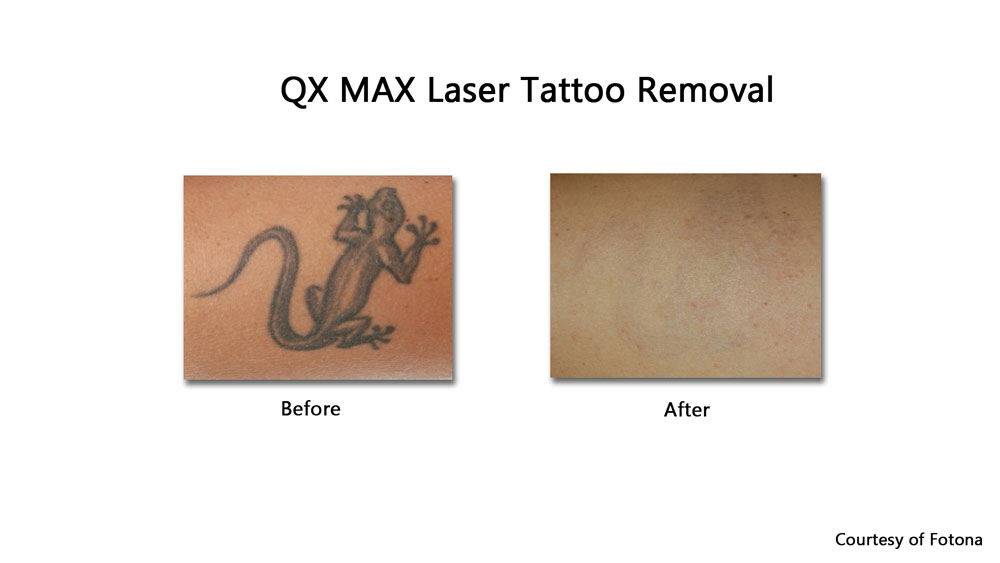
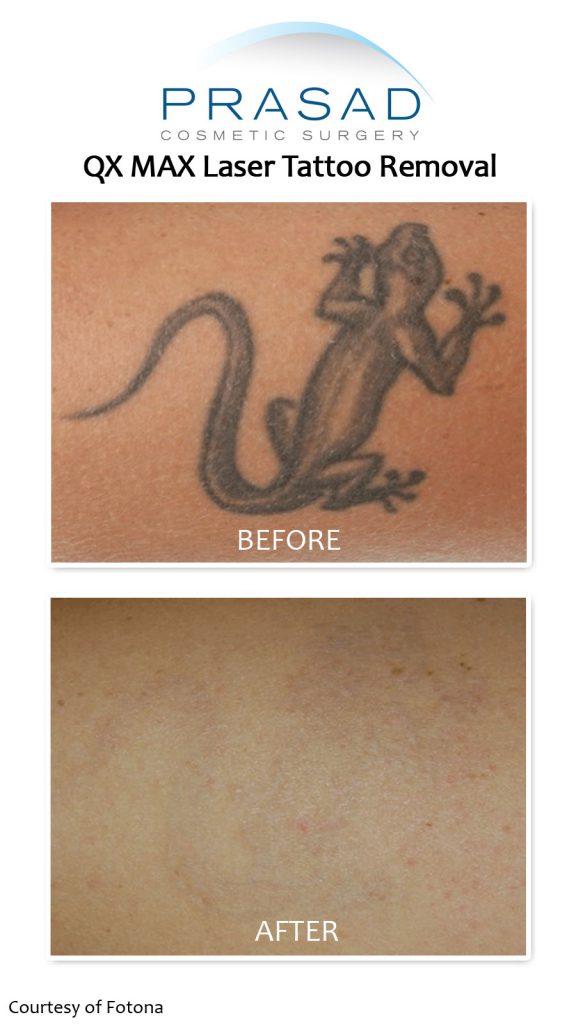
Types of Tattoos
Professional – the most common type of tattoos which use different colors of ink applied by a licensed tattoo artist with a tattoo gun and disposable needles
Amateur – Done in a variety of ways usually using only one color. Amateur tattoos also include cultural tattoo practices where only one color of ink is used, even when done by a professional/experienced tattoo artist. Amateur tattoos also include tattoos applied using professional equipment like a tattoo gun, but not applied by a licensed tattoo artist
Cosmetic – tattoos that include scalp micropigmentation and tattooed eyebrows
Medical – Similarly performed to cosmetic tattoos. These are done to indicate health cautions in individuals or in specific body parts
Traumatic – These are accidental tattoos that occur when a dark substance enters an open wound, and the skin heals over it. Also referred to as unintentional or accidental tattoos
Different Tattoo Removal Methods
Laser Removal – different types/ spectrums of lasers are used to remove different colored inks. Different colored inks absorb different spectrums of light, which is why more than one laser/wavelength may be required. This is the most effective and predictable way to remove tattoos
Dermabrasion – limited to superficial tattoos where ink is at the top layer of skin
Salabrasion – gauze pads moistened with a salt solution to abrade the skin by rubbing. This method is most prone to abuse and injury as it is often self-performed by non-physicians
Excision – surgical removal of tattooed skin
DIFFERENT LASERS FOR REMOVING DIFFERENT COLORS OF INK

Older lasers, which are still in use today for tattoo removal, are switched out depending on the color of the ink to be removed. Different colored inks need a different laser beam spectrum for removal. Q-Switched lasers deliver high-intensity heat in nanosecond pulses (billionths of a second) foto break apart ink embedded into the skin, and are the gold standard laser for tattoo removal.
Older Q-Switch Lasers
Q-Switched Ruby laser – 694 nanometer (nm) spectrum – an older laser used for eliminating black, blue, and green pigments
Q-Switched Alexandrite laser – 755 nm spectrum – another older laser used for removing black, blue, and green pigments.
Q-Switched ND: Yag 532 nm and 1064 nm spectrum – 532nm spectrum is used for red pigment, while the 1064 spectrum is used for black and blue pigment
PicoSure Laser
The PicoSure laser uses picoseconds, or trillionths of a second. PicoSure lasers break up tattoo ink into smaller particles however PicoSure lasers are not effective with red ink. Generally, PicoSure treatment does cost more than other lasers due to the price of the device.
Additionally, while the shorter exposure of the picosecond wavelength does decrease chances of overexposure to heat, it may be too short to remove more difficult inks. Dr. Prasad chose not to use this laser because of these limitations.
Best Laser for Tattoo Removal
Next Generation Q-Switch Lasers
The next generation Q-Switch laser is QX Max by Fotona, which is the preferred tattoo removal laser technology of Dr. Prasad. Unlike older Q-Switch lasers, the QX Max is a single pulse laser rather than older multi-pulsed lasers, so it is not affected by optical shielding from previous pigment destruction, making it more efficient and effective by reaching deeper layers and more pigments in a single session.
The larger spot size of the laser reduces the chances of complications due to tissue splatter, bleeding, and changes in skin texture.
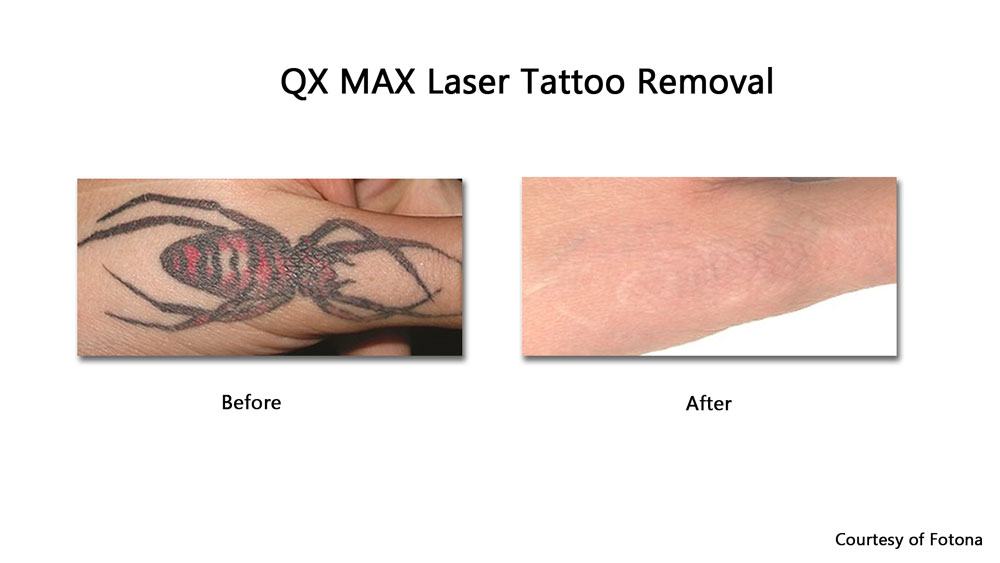
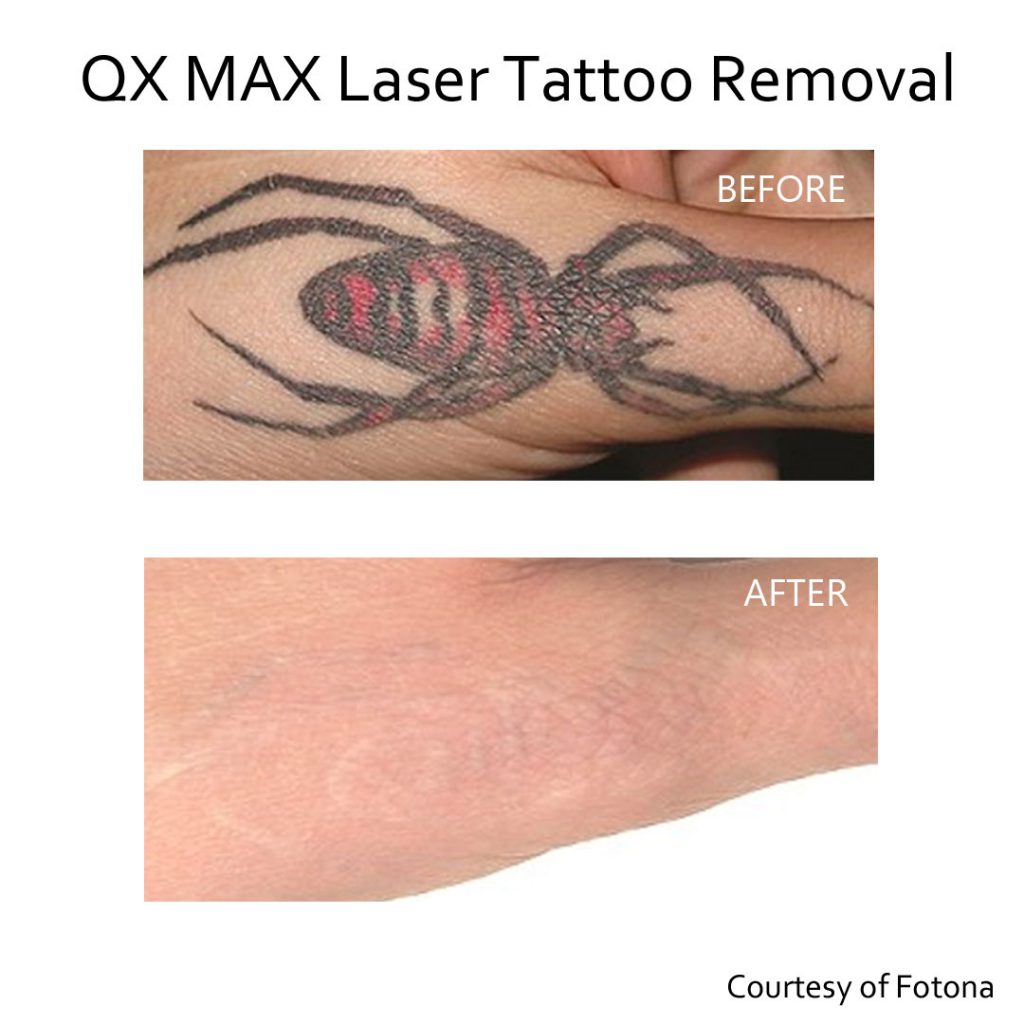
Four Wavelengths to Treat All Ink Colors
While it does remain that different lasers are needed to treat the full spectrum of colored pigments, the QX Max Q-Switch has four laser wavelengths to treat all tattoo ink colors – basically it’s four lasers in one unit, making it more convenient for the patient to have their tattoo removed.
Wavelengths:
1064 nm Nd:YAG – Nd:YAG stands neodynium: yitrium aluminium garnet, the synthetic crystal that makes up the focal point of the laser. The 1064 nm is the common setting for Nd:YAG lasers, which is appropriate for darker ink removal
532 nm KTP – KTP stands for potassium titanyl phosphate, which is what the crystal the laser uses to double its frequency, and can eliminate lighter pigmented tattoo inks such red, tan, purple, and orange
650 nm and 585 nm dye – Dye lasers use liquid instead of crystals as the medium, and are the easiest lasers to change for wavelength. The 650 nm is best for green tattoo inks, while 585 nm is treats sky blue inks.
How Does Laser Tattoo Removal Work?

Assessment – the Kirby-Desai Scale
Not all tattoos are equally difficult or easy to remove as certain factors outside of laser or other removal methods contribute to them. The Kirby-Desai scale takes several factors of tattooing and tattoo removal, and assigns each of them a score, with the total score adding to how many treatments will likely be needed for tattoo removal:
- Patient Skin Type – All skin types and skin tones can have laser tattoo removal, but darker skin tones with more melanin are more prone to hyperpigmentation (darkening of skin in treatment area) and hypopigmentation (lightening of skin in treatment area). Lighter skin types need fewer sessions for tattoo removal, while darker skin types need more sessions, but done under lower power settings and longer periods between treatment sessions.
- Location of Tattoo – Laser tattoo removal shatters ink trapped in the dermal layer of the skin into smaller particles, allowing the immune system to flush it away through the circulatory and lymphatic systems. As such, tattoos closer to the heart and major blood vessels fade faster than tattoos in other parts of the body with less blood circulation, so tattoos on high circulation areas like the chest need fewer laser treatment sessions than the extremities with less circulation like the feet and hands.
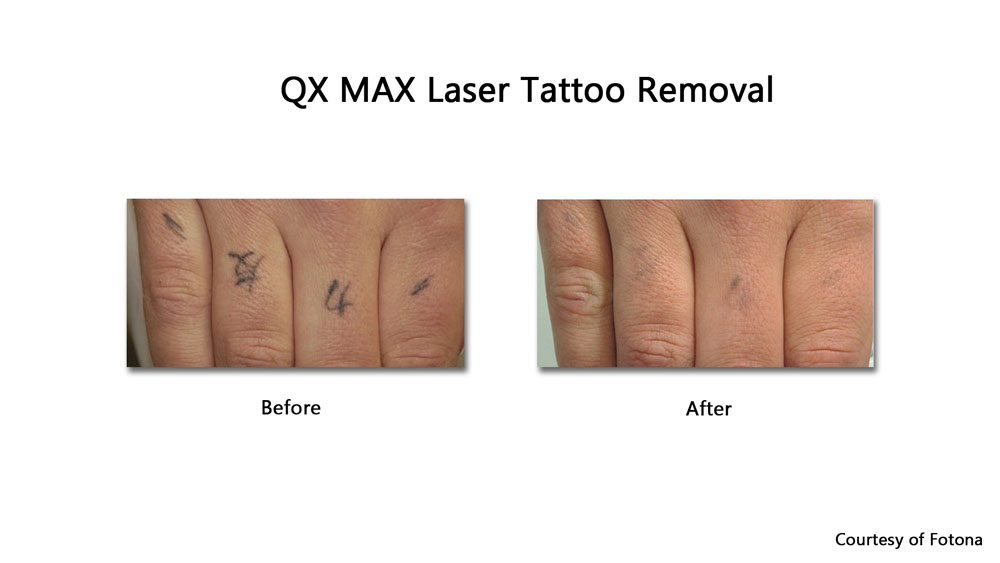
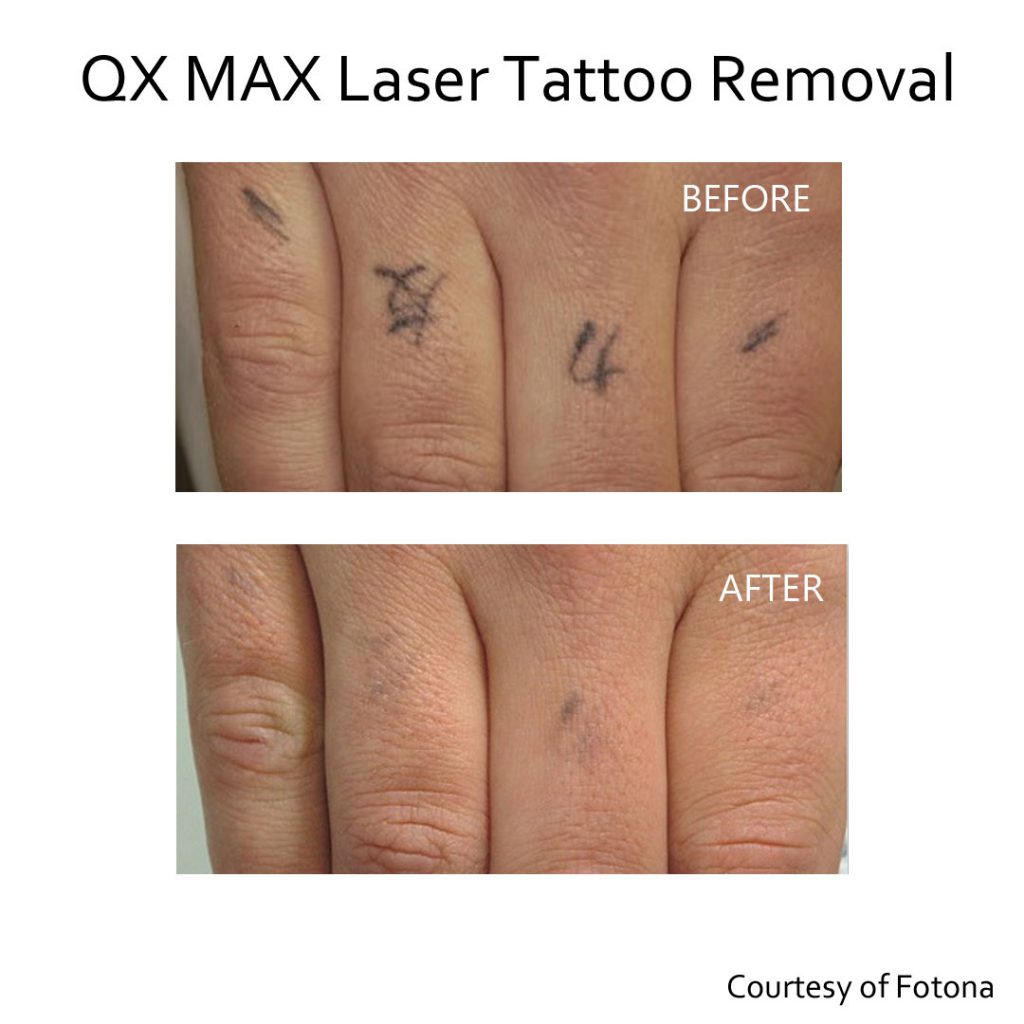
3. Ink Colors – Black is the easiest tattoo ink to get rid of as the color absorbs all light wavelengths. Red is the second easiest to remove, but cannot be removed by PicoSure lasers. Green, yellow, and blue are among the harder colors to remove, which is why different wavelengths of laser are needed for intricately colored tattoos.
4. Amount and Depth of Ink – Professional tattoos tend to be more evenly colored, contain more ink, are placed deeper in the dermis with the use of a tattoo gun, and are generally larger than amateur tattoos. Amateur tattoos tend to have less ink, less evenly applied, closer to the skin surface, and also use less colors, so they are easier to remove than professional tattoos.
5. Scarring/ Tissue Change – Tattoos applications that resulted in scarring are more difficult to remove. Darker skin types are more prone to scarring during tattoo application, so this is another factor where darker skin types may need more removal sessions.
6. Layering/ Cover- Ups – Newer, larger tattoos are often used to cover-up older, unwanted tattoos. The newer tattoo also uses more ink to cover the old tattoo. The removal process will normally remove the newer tattoo first, then reveal the older tattoo, which will take more treatment sessions than just removing one tattoo with a smaller amount of ink.
How many laser treatments to remove a tattoo?
Depending on the Kirby-Desai factors, tattoo removal using the QX Max laser system would be anywhere from 3-10 treatment sessions, 4-8 weeks apart.
Get started today in removing your unwanted tattoo. Call us at (212) 265-8877 in Manhattan, NYC, or (516) 742-4636 Garden City (Long Island), or fill out the contact form below, and we will get back to you. We also have Spanish-speaking staff.
